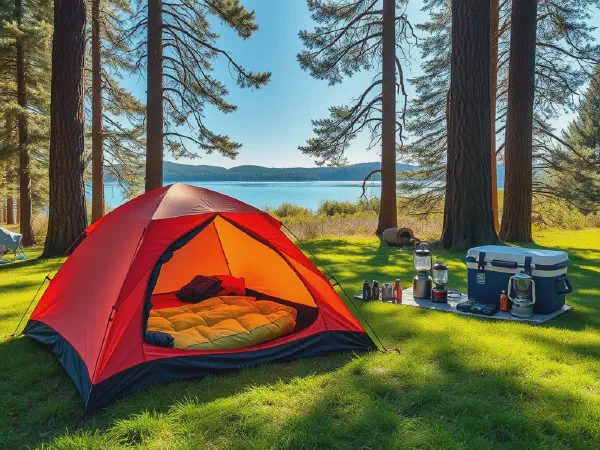The Ultimate Guide to Camping Gear: Tents, Sleeping Bags & More

The Ultimate Guide to Camping Gear: Everything You Need for Your Next Outdoor Adventure
Camping gear is essential for a successful and enjoyable outdoor experience. Whether you are a seasoned camper or a first-time adventurer, having the right equipment can make all the difference. From tents and sleeping bags to cooking supplies and safety gear, understanding what camping gear you need will help you prepare for your trip into nature.
When planning a camping trip, it’s crucial to consider the camping gear that suits your style and destination. Different environments, weather conditions, and personal preferences can dictate the type of equipment you will require. Investing in reliable camping gear not only enhances comfort but also ensures safety and convenience during your outdoor escapades.
As you explore the vast selection of camping gear available today, it’s important to prioritize functionality, durability, and ease of use. From high-tech gadgets to classic outdoor essentials, having the right gear can elevate your camping experience to new heights. With the proper camping gear, you can focus on enjoying the great outdoors rather than worrying about unforeseen issues.
This comprehensive guide will delve into the various types of camping gear you should consider, including tents, sleeping bags, cooking equipment, and essential accessories. We’ll also provide practical tips for setting up your campsite so you can fully embrace the joys of camping without the stress of being unprepared.
Equip yourself with the knowledge you need to choose the right camping gear for your next adventure and make memories that last a lifetime!
Types of Camping Tents
For backpackers, the best tents are those that are lightweight, compact, and easy to set up. Look for options like the ultralight tents made of high-durability materials. These tents often come with a minimalist design, providing enough shelter while keeping weight to a minimum, making them ideal for long hikes and travel.
Camping tents for families should prioritize space, comfort, and ease of assembly. Look for tents with multiple rooms, high ceilings, and sufficient ventilation. Family tents should also be weather-resistant, offering protection from rain and wind while providing enough room for sleeping, playing, and relaxing together.
Seasonal tents are designed to withstand different weather conditions. Choose a three-season tent for mild weather, while a four-season tent is the best option for harsher conditions, like heavy snow and extreme winds. These tents are built to offer insulation, stability, and durability throughout the year.
Ultralight tents cater to minimalists who prioritize low weight and packability. These tents often feature innovative designs with fewer poles, lightweight materials, and the ability to be pitched with trekking poles. They're perfect for those who want the bare essentials while exploring off the beaten path.
Choosing the Right Sleeping Bags
Temperature ratings are crucial when selecting a sleeping bag. They indicate the lowest temperature at which a bag will keep you warm. A bag rated for cold weather is great for winter camping, while one rated for warmer temperatures is sufficient for summer trips. It's important to choose a sleeping bag appropriate for the conditions you expect to encounter.
Mummy bags are designed to hug your body and trap heat more effectively, making them excellent for colder climates. On the contrary, rectangular bags provide more room to move around, ideal for those who prefer a more spacious sleeping environment. Your choice may depend on personal comfort preferences and climate.
Choosing between synthetic and down fill sleeping bags depends on usage. Synthetic bags are water-resistant and easy to dry, making them great for wet conditions. Down fill provides superior insulation and compressibility, making them suitable for lightweight backpacking, but they lose insulation capability when wet.
To care for your sleeping bag, always follow the manufacturer's instructions. Store it loosely in a large sack to maintain loft, wash it only when necessary, and ensure it's completely dry after washing. Proper care will extend the life of your sleeping bag and keep it performing well.
Essential Camping Gear Checklist
For first-time campers, must-have items include a tent, sleeping bag, and sleeping pad. Additionally, a flashlight or headlamp, camping stove, cooking supplies, water purification system, and a first aid kit are essential. Don’t forget insect repellent and sunblock for added protection when outdoors.
Camping cooking equipment should include a portable stove or grill, cookware, utensils, and food storage containers. Consider a camping kitchen set that includes cutting boards, knives, pots, and pans for preparing meals conveniently in the wild.
Safety gear for outdoor adventures should consist of a well-stocked first aid kit, a multi-tool or knife, fire-starting supplies, a whistle for emergencies, and a reliable map or GPS device. It's critical to be prepared for unexpected situations while enjoying nature.
Comfort items can significantly enhance your camping experience. Consider packing lightweight chairs, hammocks, and portable cushions for seating. Additionally, personal items like travel pillows, toiletries, and cozy blankets can contribute to a more pleasant stay in the campsite.
Camping Accessories and Gadgets
Portable camping stoves and grills allow you to cook meals conveniently when away from home. Look for compact and easy-to-use models that offer adjustable heat settings. Solar-powered stoves are also an eco-friendly option that provides great cooking power without needing fuel.
Multi-tools and survival kits are essential for handling unexpected situations in the wilderness. These handy tools often feature knife blades, screwdrivers, can openers, and more, compactly packaged for easy transport. A well-stocked survival kit ensures you'll be prepared for emergencies.
Solar chargers for camping offer a sustainable way to keep your devices powered. These chargers can charge phones, GPS, and other electronics using sunlight, making them perfect for extended trips where power sources are unavailable.
Camping furniture for comfort includes foldable chairs, tables, and even cots. These items contribute to a homely atmosphere and provide necessary relaxation options after a day of outdoor adventures. Invest in durable and lightweight furniture to enhance your camping experience.
Tips for Setting Up Your Campsite
Choosing the best campsite location involves finding flat ground away from potential hazards like falling branches or flooding areas. Ensure you’re close to water sources yet distanced from animals and trails. Research permits and campsite regulations before heading out.
Setting up your tent efficiently saves time and energy. Select a spot free from debris, and orient your tent door away from prevailing winds. Practice setting up your tent at home to get familiar with it, ensuring you can pitch it quickly once you reach your site.
Organizing your camping gear helps keep your workspace tidy and makes accessing your equipment easier. Use storage bins or backpacks to separate cooking utensils, sleeping gear, and safety equipment, allowing you to find items quickly and efficiently while on-site.
Safety tips for campsites include maintaining a safe distance from campfires, keeping food securely stored to avoid attracting wildlife, and practicing proper waste disposal. Always be aware of the local wildlife and regulations to ensure a safe camping experience.
